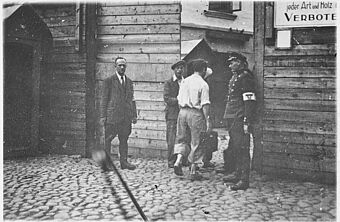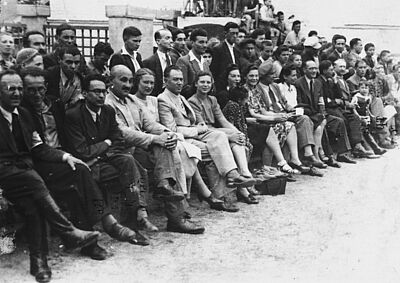In June 1941, German soldiers marched into Vilna. One of the cultural and intellectual centres of European Jewry, it was known as the ‘Jerusalem of Lithuania’. At the beginning of July, Nazis drove a group of Jewish men to the nearby forest of Ponar and murdered them, beginning a cycle of killings that spanned the summer months.
In September, the remaining Jews in the city (almost 40,000) were driven into two ghettos, which had been established in the old Jewish quarter. Massacres continued in September and October, and the smaller second ghetto was soon closed. As elsewhere, the ghetto was massively overcrowded, food was inadequate and disease was rampant.
Despite the conditions, the inmates of the Vilna ghetto established a vast array of cultural, intellectual and artistic organisations. This cultural vitality in many ways marked a continuity with the pre-war years: for centuries, the city had been a centre for Jewish arts, theatre and publishing. In addition, the socialist Bund had been founded there in 1897, and this tradition of Jewish radicalism continued through the war years in the activism of the ghetto’s underground resistance group, the Fareynigte Partizaner Organizatsye (United Partisans’ Organisation, FPO). The ghetto housed its own symphony orchestra, chamber groups and Yiddish and Hebrew choirs. There were also religious and secular schools, orphanages, a large public library, and even a music school with more than 100 students.
Vilna’s renowned theatrical tradition also continued in the ghetto, where several theatres existed during its two-year existence. In January 1942, the first ghetto theatre was opened on Konska Street, which employed many local writers and artists. Many of the productions were revues: mixtures of short skits, poems and musical numbers, which dealt directly with the situation in the ghetto and the concerns and fears of its residents. Most of the new melodies composed in the ghetto were in fact created in the theatre. Every few months a new revue was organised, including ‘Peshe fun Reshe’ (Peshe from Rzesza) and ‘Moyshe Halt Zikh’ (Moyshe, hold on); some of the important writers and composers included Kasriel Broydo, Leyb Rozental and Misha Veksler. There was also a smaller theatre on Rudnicka Street.
The first concert of the symphony orchestra, conducted by Jacob Gerstein, took place on 18 January 1942 under the sponsorship of Jewish Council leader Jacob Gens and the ghetto police. It was a memorial tribute to the murdered Jews and included many songs of loss and mourning, such as ‘I am moved to weep’ by Chaim Nachman Bialik, works by Chopin and singing by the soprano Lyube Levitski. The performance was a great success, and the money raised was donated to social welfare causes in the ghetto. Just a few days later, the FPO was founded, uniting youth of diverse political persuasions under the motto of ‘not dying like sheep to the slaughter’. The partisan movement was also a rich site of song- writing. Probably the single most famous song to come out of a ghetto during the Holocaust was the Vilna resistance fighter Hirsh Glik’s song ‘Zog nit keynmol az du geyst dem letstn veg’ (Never say that you are walking the final road). The song was an instant hit, and spread quickly amongst partisans and through ghettos and camps; it was being sung widely in Europe before the war had ended. Also popular were the songs written by Avraham Sutzkever, and especially the partisan-poet Shmerke Kaczerginski.
While the FPO relied on songs to arouse political awareness and build community, they were also some of the harshest critics of organised musical entertainment programnes within the ghetto. Many political and religious organisations in Vilna, including the Bund, boycotted concerts, distributing leaflets that declared: 'Theatrical performances should not be held in cemeteries.' Eventually, however, as the scale of daily suffering persisted and the success of music in inspiring and comforting the people became clearer, most came to accept the concerts. Ghetto inmate Hermann Kruk, originally bitterly opposed to concerts, wrote in his diary on 8 March 1942:
the pulse of life begins to beat again in the Vilna ghetto … the concerts, which were at first boycotted, have been accepted by the public; the halls are full.
In general, the populace of the Vilna ghetto strongly supported this variety of cultural activity. In particular the many new songs composed about Jewish life in the ghetto were sung by inmates at work, at small impromptu concerts, in street performances and at schools and community centres.
On 15 January 1943, the Jewish Council sponsored a celebration of the cultural achievements of the ghetto. At that concert, Council leader Gens proclaimed proudly:
We wanted to give people the opportunity to free themselves from the ghetto for several hours, and this we achieved. We are passing through dark and difficult days. Our bodies are in the ghetto but our spirit has not been enslaved … before the first concert it was said that concerts should not be held in graveyards. True, the statement is true, but all of life is now a graveyard. Our hands must not falter. We must be strong in body and soul.
On 23 September 1943, the Vilna ghetto was liquidated, the last survivors either killed or sent to camps. Several thousand of the younger and healthier inhabitants were selected to survive temporarily as slave labour, the men sent to Estonia and the women to camps in Latvia. At the liberation of the city by the Soviet army in July 1944, there were only a few hundred Jewish survivors.
Sources
Aaron, F., 1990. Bearing the unbearable: Yiddish and Polish poetry in the ghettos and concentration camps, Albany, NY: State University of New York Press.
Adler, H. & Richter, M., 1994. Gesänge aus der Stadt des Todes: Todeslagergedichte aus dem Wilnaer Ghetto 1941/42, Berlin: Hentrich.
Arad, Y., 1980. Ghetto in Flames: The Struggle and Destruction of the Jews in Vilna in the Holocaust, Jerusalem: Yad Vashem: Martyrs' and Heroes' Remembrance Authority Ktav Pub. House.
Freund, F., Ruttner, F. & Safrian, H. eds., Ess Firt Kejn Weg Zurik.: Geschichte und Lieder des Ghettos von Wilna, 1941-1943, Vienna: Picus.
Gilbert, S., 2005. Music in the Holocaust: Confronting Life in the Nazi Ghettos and Camps, Oxford: Oxford University Press.
Stompor, S., 2001. Judisches Musik- und Theaterleben unter dem NS-Staat, Hannover: Europaisches Zentrum fur Judische Musik.









